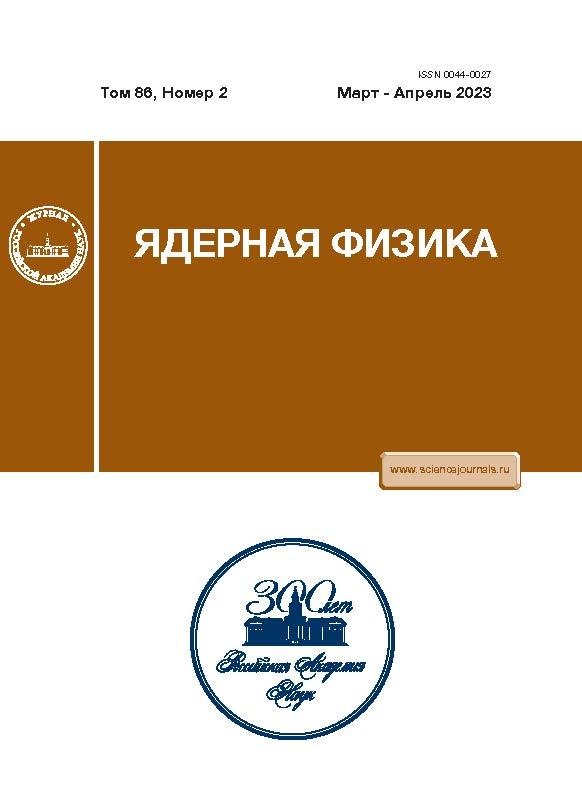Structures of Weak-Mixing Matrices As a Consequence of Broken Mirror Symmetry
- Autores: Dyatlov I.T.1
-
Afiliações:
- Petersburg Nuclear Physics Institute, National Research Center Kurchatov Institute
- Edição: Volume 86, Nº 2 (2023)
- Páginas: 320-336
- Seção: ЭЛЕМЕНТАРНЫЕ ЧАСТИЦЫ И ПОЛЯ. Теория
- ##submission.datePublished##: 01.04.2023
- URL: https://cardiosomatics.ru/0044-0027/article/view/674715
- DOI: https://doi.org/10.31857/S004400272302006X
- EDN: https://elibrary.ru/RIRHON
- ID: 674715
Citar
Texto integral
Resumo
A model of symmetry breaking is described for a system that may spontaneously choose between a left-handed and a right-handed weak current. For a hierarchic structure of the fermion mass spectrum, this mirror-symmetric system permits reproducing all qualitative properties of the weak-mixing matrices for both quarks (CKM matrix) and leptons (PMNS matrix) without numerically adjusting model parameters. The hierarchy of the CKM matrix elements is directly related to the hierarchic mass spectrum of quark generations. Qualitative properties of the PMNS matrix arise in the case where the spectrum has an inverse character (@ is the smallest mass) and where the Standard Model neutrino is a Dirac particle. A relative smallness of the neutrino-mixing angle @ is due here to the smallness of @ and the smallness of the charged-lepton mass ratio
.
Sobre autores
I. Dyatlov
Petersburg Nuclear Physics Institute, National Research Center Kurchatov Institute
Autor responsável pela correspondência
Email: dyatlov@thd.pnpi.spb.ru
Gatchina, Russia
Bibliografia
- T. D. Lee and C. N. Yang, Phys. Rev. 102, 290 (1956).
- T. D. Lee and C. N. Yang, Phys. Rev. 104, 254 (1956).
- J. Maalampi and M. Roos, Phys. Rep. 186, 53 (1990).
- L. B. Okun, hep-ph/0606202; Phys. Usp. 50, 380 (2007).
- A. B. Kaganovich, arXiv: 2105.03878 [hep-ph].
- G. Triantophyllou, arXiv: 1609.03404 [physics, gen-ph].
- P. Q. Hung, Phys. Lett. B 649, 275 (2007); Pai-Hong Gu, Phys. Lett. B 713, 425 (2012).
- S. Chakdar, K. Gosh, S. Nandi, and S. K. Rai, arXiv: 1305.2641 [hep-ph].
- H. Fritzsch, Phys. Lett. B 70, 436 (1977); 73, 317 (1978).
- C. D. Froggatt, M. Gibson, H. B. Nielsen, and D. J. Smith, hep-ph/9706212; C. D. Froggatt and H. B. Nielsen, hep-ph/9905445.
- И. Т. Дятлов, ЯФ 77, 775 (2014) [Phys. At. Nucl. 77, 733 (2014)]; arXiv: 1312.4339 [hep-ph].
- R. N. Mohapatra and A. Y. Smirnov, hep-ph/0603118; S. F. King, A. Merle, S. Morisi, Y. Shimizu, and M. Tanimoto, arXiv: 1402.4271 [hep-ph]; L. Maiani, arXiv: 1406.5503 [hep-ph].
- И. Т. Дятлов, ЯФ 78, 522 (2015); 78, 1015 (2015); 84, 460 (2021) [Phys. At. Nucl. 78, 485 (2015); 78, 956 (2015); 84, 773 (2021)]; arXiv: 1502.01501; 1509.07280 [hep-ph].
- S. Gariazzo, M. Gerbino, T. Brickmann, M. Lattanzi, O. Mena, T. Shwetz, S. R. Chouldhury, K. Freese, S. Hannestad, C. A. Ternes, and M. Tortola, arXiv: 2205.02195v1 [hep-ph].
- R. L. Workman et al. (Particle Data Group), Prog. Theor. Exp. Phys. 2022, 083C01 (2022).
- И. Т. Дятлов, ЯФ 80, 368 (2017) [Phys. At. Nucl. 80, 679 (2017)]; arXiv: 1703.00722 [hep-ph].
- S. L. Adler, Phys. Rev. 177, 2426 (1969); J. Preskill, Ann. Phys. (N.Y.) 210, 323 (1991).
- И. Т. Дятлов, ЯФ 80, 253 (2017) [Phys. At. Nucl. 80, 469 (2017)].
- F. Bernard, arXiv: 1611.0859 [hep-ph].
- L. Wolfenstein, Phys. Rev. Lett. 51, 1945 (1983).
- C. D. Froggatt and H. B. Nielsen, Nucl. Phys. B 147, 277 (1979); C. D. Froggatt, G. Lowe, and H. B. Nielsen, Nucl. Phys. B 414, 579 (1994).
- M. Leurer, Y. Nir, and N. Seiberg, Nucl. Phys. B 398, 319 (1993); 420, 468 (1994); hep-ph/9212298; hep-ph/9310320.
- M. Fedele, A. Mastroddi, and M. Valli, arXiv: 2009.05587 [hep-ph].
Arquivos suplementares












